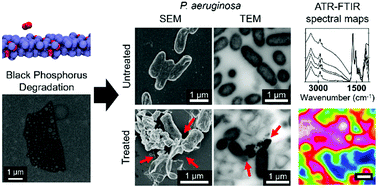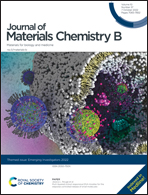Illuminating the biochemical interaction of antimicrobial few-layer black phosphorus with microbial cells using synchrotron macro-ATR-FTIR†
Abstract
In the fight against drug-resistant pathogenic bacterial and fungal cells, low-dimensional materials are emerging as a promising alternative treatment method. Specifically, few-layer black phosphorus (BP) has demonstrated its effectiveness against a wide range of pathogenic bacterial and fungal cells with studies suggesting low cytotoxicity towards healthy mammalian cells. However, the antimicrobial mechanism of action of BP is not well understood. Before new applications for this material can be realised, further in-depth investigations are required. In this work, the biochemical interaction between BP and a series of microbial cells is investigated using a variety of microscopy and spectroscopy techniques to provide a greater understanding of the antimicrobial mechanism. Synchrotron macro-attenuated total reflection-Fourier transform infrared (ATR-FTIR) micro-spectroscopy is used to elucidate the chemical changes occurring outside and within the cell of interest after exposure to BP nanoflakes. The ATR-FTIR data, coupled with high-resolution microscopy, reveals major physical and bio-chemical changes to the phospholipids and amide I and II proteins, as well as minor chemical changes to the structural polysaccharides and nucleic acids when compared to untreated cells. These changes can be attributed to the physical interaction of the BP nanoflakes with the cell membranes, combined with the oxidative stress induced by the degradation of the BP nanoflakes. This study provides insight into the biochemical interaction of BP nanoflakes with microbial cells, allowing for a better understanding of the antimicrobial mechanism of action that will be important for the next generation of applications such as implant coatings, wound dressings, or medical surfaces.

- This article is part of the themed collections: Journal of Materials Chemistry B Emerging Investigators and 2022 Journal of Materials Chemistry B Most Popular Articles


 Please wait while we load your content...
Please wait while we load your content...